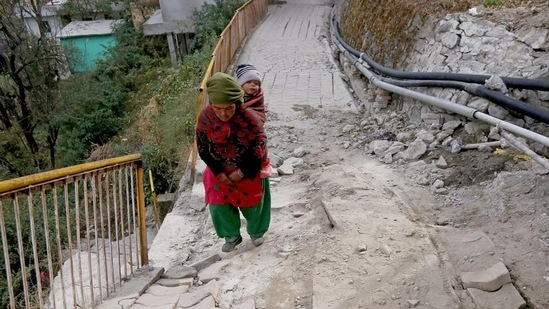Monitor construction in the Himalayas to avoid tragedy
Instead of clearing projects in a piecemeal manner, the Himalayan area must be taken as a single unit for purposes of environmental impact assessment, which must be taken far more seriously.
Joshimath is a sad story of humankind’s insatiable desires clashing with nature’s limited resources. It also shows that when modern planners ignore the traditional wisdom of our ancestors, tragedies occur.

Originally called Jyotirmath, the holy town is a seat of Vedic sanatana dharma and Adi Shankaracharya established one of the four mathas here. Its population was never more than a few hundred people, and mostly comprised monks, priests and their families. This region — with Mana as the last village before the China border — bordered Tibet, and was on the popular route to Kailash Mansarovar. Due to its strategic location, a heavy presence of armed forces was built up over the years, especially in the decades following the 1962 India-China war. Its location on the main route to the Badrinath shrine attracted a large number of pilgrims, bringing with it a new wave of urbanisation that saw it grow haphazardly and rapidly. The results are there for all to see today.
Joshimath was sandwiched by two huge nullahs that worked as natural drainage, but they were allowed to be filled and erased by unchecked construction. Our ancestors knew the significance of the drainage, but that knowledge was lost. As Piyoosh Rautela, executive director at the Uttarakhand State Disaster Management Authority (USDMA), puts it, the people of the region understood the relationship between groundwater infiltration and slope instability, and accordingly identified slide-prone areas to ensure safe disposal of excess rainwater into nearby water channels. The geological disposition and presence of thick piles of debris made this place unsuitable for bearing the load of buildings and other structures that were constructed without thought.
This is particularly galling because examples of more sensitive construction abound in the state. Take, for example, the Kedarnath Temple, which has withstood centuries of avalanches and natural catastrophes. In the words of RS Fonia, former director of the Archaeological Survey of India, the right selection of stones was used for the temple and it was designed in a way that didn’t disrupt the local ecosystem.
The phenomenon isn’t limited to Joshimath. Examples of nature revolting against man-made assaults can be seen in Gopeshwar, Almora, Tehri, Haldwani, Haridwar, and even in the state capital Dehradun. A USDMA survey found that 19,000 government buildings in various parts of the state such as Doon Medical College, Sachivalaya, Vidhan Sabha, in addition to malls, cineplexes, five- and seven-star hotels — all built on congested roads — remain vulnerable to earthquake and other natural disasters. Allowing big malls on arterial roads such as Hathibarkala road (in Dehradun) has destroyed the breathing spaces of the city. Building multi-storeyed concrete structures on playgrounds (Dehradun’s famous parade ground has fallen prey to it) are invitations for disaster.
What is the way out? I believe instead of clearing projects in a piecemeal manner, the Himalayan area must be taken as a single unit for purposes of environmental impact assessment, which must be taken far more seriously. Tunnels, highways and houses cannot be segregated for clearances. The state government and disaster management authorities need to take ownership of the area, decide if a particular piece of construction is going to render the entire region vulnerable, and clamp down on unchecked construction. We cannot play with nature’s patience anymore. This is all the more alarming because what wrecked Joshimath — unchecked settlements and construction — can already be seen choking other pristine areas, such as Devprayag that marks the confluence of the Alaknanda and Bhagirathi, and the birth of the mighty Ganga. But the tragedy should not be used by some people to stop development, or jeopardise livelihoods in a sensitive border area.
When he was the chief minister of Gujarat, Prime Minister (PM) Narendra Modi meticulously planned the reconstruction and rehabilitation of tens of thousands of people after the 2001 Bhuj earthquake, setting an example for the country and the world. As PM, he elaborated on a doctrine for disaster resilience: Imbibing the principles of disaster risk management, including the poor in risk coverage, making women’s leadership central, investing in risk mapping globally, leveraging technology, building a network of universities, enhancing local capacities and initiatives, studying every disaster for lessons, and bringing greater cohesion in international responses to disasters.
The state government must act on this agenda to mitigate future disasters. Strict rules need to be made and followed, structural monitoring cells need to be set up, and a separate hill area development commission should be constituted to probe every new project proposal through the prism of geological and ecological safety. Our dev bhoomi needs a healing touch.
Tarun Vijay is a former MP and former chairman of the National Monuments Authority
The views expressed are personal
All Access.
One Subscription.
Get 360° coverage—from daily headlines
to 100 year archives.



HT App & Website







